Partnership Action for Continuing Employment: client experience survey 2020
This report provides key findings on the influence of the Scottish Government's initiative for responding to redundancy situations, Partnership Action for Continuing Employment (PACE).
This document is part of a collection
4. Client Views On Pace Services
Chapter summary
This chapter looks at client uptake of PACE services in 2020 and their views of these services in terms of satisfaction, relevance and usefulness. It also investigates the perceived timeliness of the delivery of these services. The key findings of this chapter are outlined below:
- As expected, the introductory PACE presentation and information pack continues to be the most commonly accessed service (used by 81% of clients in 2020). However, compared to 2018, the proportion of clients going on to take up further PACE services (as well as the presentation and information pack) had increased.
- Overall average satisfaction with PACE services continues to be high, with an average of 86% of clients saying that they were satisfied with each service. This has remained stable with 2018 (where 85% were satisfied on average).
- PACE services continue to be relevant to individuals facing redundancy, with an average of 78% of clients feeling each service was relevant in 2020 compared to 79% in 2018. In particular, clients in 2020 felt that the following services were most relevant: help with CVs/applications/letters (88%), the Money Advice Service (88%), help with interviews/job search strategies (86%), and a handbook titled ‘Positive Steps to your Future’ (85%).
- Overall, three-quarters or more of clients were satisfied with the timeliness of PACE services, feeling that the timing was ‘perfect’ or ‘about right’ for each service, with the most positive ratings being given to support received through the Money Advice Service (92% felt it was ‘perfect’ or ‘about right’), help with understanding tax responsibilities (87%) and help to cope with redundancy-related stress (85%). The improvement related to timeliness of service delivery noted in 2018 has been sustained in 2020: 23% in 2020 compared to 25% in 2018 and 30% in 2016. Only seven % of 2020 respondents felt that any service was received too early.
- Four in ten clients were aware of the online (42%) and telephone (38%) PACE services but uptake was low with only 13% and four % making use of these services respectively. In line with previous years, satisfaction was encouragingly high amongst those who had used this support, with around 90% stating that they were satisfied.
4.1 PACE supports its customers with a wide range of services, from careers guidance and assistance with job searches and different stages of a job application process, to information about how to cope with their redundancy, both financially (including information on access to benefits) and in terms of managing resulting stress.
4.2 The survey of new clients in 2020 measured the relevance and usefulness of each of the PACE services as perceived by those that used them, and the satisfaction clients had with the services delivered to them.
4.3 This chapter presents the outcomes of these key performance indicators and examines the extent to which clients who accessed the different services felt they were being made available at the right time in their redundancy.
Packages of PACE services accessed
4.4 As in previous years, it was most common for clients to have accessed the PACE presentation and information pack (81% had done so in 2020), followed by information about training and funding sources (62%), help with CVs/applications/letters (59%), and benefits information (57%).
4.5 Notably the proportion of clients going on to take up support services in addition to the PACE presentation and information pack has increased. In 2020, 74% had accessed other services as well as the PACE presentation, compared to 66% who had done so in 2018.
4.6 Use of several individual services had risen significantly as well, potentially reflecting a different approach to promotion of these services. The proportion of clients benefiting from help with CVs/applications/letters increased by eight %age points, use of benefits information increased by 11 %age points, use of help with interview/job search strategies increased by eight %age points and use of the handbook ‘Positive Steps to your Future’ increased by 12 %age points. Figure 4.1 shows the level of take-up across PACE services in 2020 compared to 2018.
4.7 The proportion of clients who only accessed the PACE presentation remained consistent (seven % in 2020 compared to nine % in 2018).
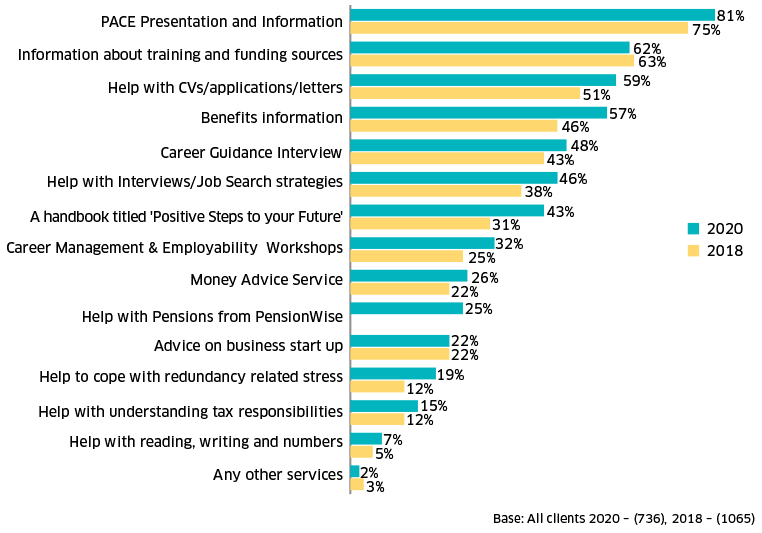
Satisfaction with PACE services
4.8 Levels of satisfaction with PACE services have remained consistently high since 2018. Across all services the average satisfaction score was 86% (combining the proportion of clients who were either ‘very satisfied’ or ‘quite satisfied’). This is in line with an average satisfaction score of 85% in 2018 and 84% in 2016.
4.9 Clients expressed consistently high level of satisfaction with all services within the suite of PACE support; this is shown in Figure 4.2. The PACE services with the highest overall satisfaction levels in 2020 were: help with CVs, applications and letters (91%), the PACE presentation and information (90%), help to cope with redundancy-related stress (90%) and help with interviews and job searches (90%). These services are diverse in their content and suggest satisfaction across a variety of PACE services. It is also extremely positive that clients are satisfied with the PACE presentation and information pack given that this is likely to be their first point of contact with the PACE suite of resources.
4.10 Clients were most likely to be ‘very satisfied’ with the more practical forms of employment support, such as help with writing their CVs/applications/letters (63%) and help with interviews or job search strategies (60%).
4.11 Compared to 2018, clients were significantly more satisfied with certain services. Satisfaction with the PACE presentation and information pack had increased by four %age points, the Money Advice Service satisfaction score had risen by eight %age points and help with interviews and job search strategies had increased by six %age points.
4.12 While a comfortable majority were still satisfied overall with the help they had received with reading, writing and numbers, this continued to receive the lowest satisfaction score, at 74% saying they were satisfied. This is in line with the findings from 2018.
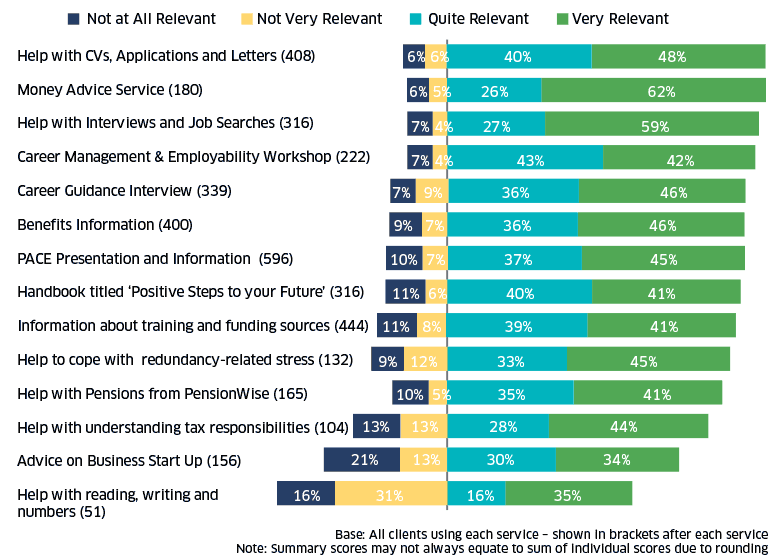
4.13 Time series tables showing the satisfaction scores with individual services across the survey series is provided in Appendix A.
Perceived relevance of PACE services
4.14 Clients were also asked to rate the relevance of each of the PACE services that they had accessed. Encouragingly, PACE services continue to be very relevant to those who use them: average levels of relevance have remained consistently high since 2018, with 78% feeling that the services they had accessed had been relevant to them in 2020. This is in line with 79% reported in both the 2018 and 2016 surveys.
4.15 Clients found the following PACE services most relevant overall (rating them as either ‘very relevant’ or ‘quite relevant’): help with CVs/applications/letters (88% found this service relevant), the Money Advice Service (88%, a significant increase from 73% in 2018), help with interviews/ job search strategies (86%), and the ‘Positive Steps to your Future’ handbook (85%). Figure 4.3 shows the proportion of clients rating each service from ‘very relevant’ to ‘not at all relevant’.
4.16 Services providing practical advice for finding new employment were the most likely to be perceived as highly relevant, in line with the 2018 findings. For example, the services most likely to be reported as ‘very relevant’ were help with CVs, applications and cover letters (62% found this ‘very relevant’, up by nine %age points from 2018), help with interviews and job strategies (59%, up by 12 %age points from 2018) and the career management and employability workshops (46%, consistent with 2018).
4.17 Clients were least likely to think of help with reading, writing and numbers as relevant (only 51% felt it was ‘very’ or ‘quite’ relevant); this is a substantial decrease of 19 %age points from 70% in 2018. Indeed, almost a half (47%) felt that this support was either ‘not at all’ or ‘not very’ relevant to them.
4.18 As in 2018, relatively low proportions felt that advice on starting up a business (64%; the same as in 2018) was relevant to them, while around a third (35%) of clients who had accessed this support considered it either ‘not at all’ or ‘not very’ relevant.
4.19 Notably, the proportion finding help with understanding tax responsibilities relevant had significantly decreased from 86% in 2018 to 72% this year, while a quarter (26%) of respondents felt this support was either ‘not at all’ or ‘not very’ relevant.
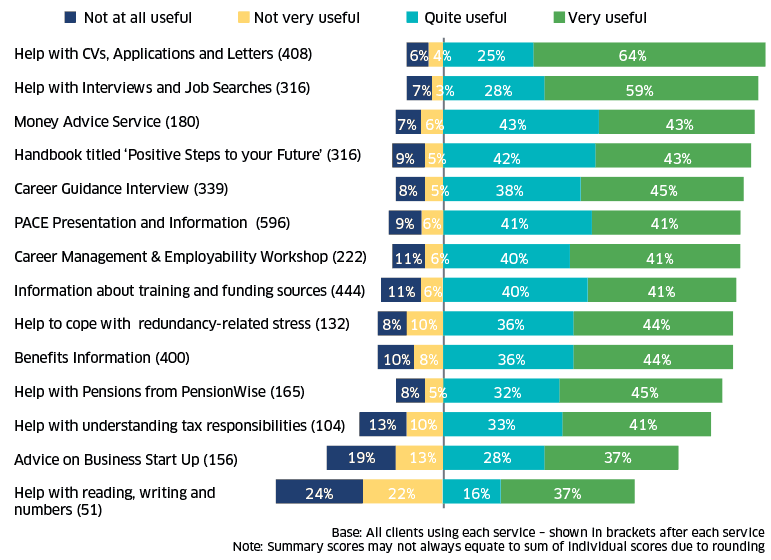
4.20 Clients were more likely to rate employment-related services as relevant if they had secured work following redundancy, compared with clients who had not secured work. In line with the findings in 2018, this was most apparent with the following services:
- Around two-thirds (63%) of clients who had secured employment rated help with CVs, applications or letters as ‘very relevant’, compared to 56% of clients who had not secured work.
- Three in five (62%) of clients who had secured employment rated help with interviews or job search strategies as ‘very relevant’, compared to 48% of clients who had not secured work.
- Almost half (48%) of the clients who secured employment rated the career planning workshop as ‘very relevant’, compared to 34% of clients who were not in work or education.
4.21 The link between employment outcome and the perceived relevance of services may explain the lower levels of perceived relevance of services such as advice on business start up (i.e. if someone received this advice but did not ultimately go on to start up their own business then they may consider the advice to have not been relevant).
4.22 Time series tables are provided in Appendix A.
Perceived usefulness of materials
4.23 Clients were asked to give their views on the usefulness of the materials they received from each of the PACE services. These are summarised in Figure 4.4, which shows that, overall, the majority of PACE clients found the materials they received to be useful, with the average level of ‘usefulness’ (combining ‘very useful’ and ‘quite useful’ across all services) at 79%. This is consistent with 2018.
4.24 In 2020, the materials that respondents found most useful were consistent with the services that clients found most relevant. The top three included material relating to help with writing CVs, applications and letters (89% found these useful), closely followed by the materials for help with interviews or job search strategies (87%) and materials provided through the Money Advice Service (86%). In 2018, the most useful service was the ‘Positive Steps for your Future’ handbook (85% in 2018, 84% in 2020).
4.25 The remaining services were all rated highly (between 70 and 85 %), with the exception of help with reading, writing and numbers (53%) and advice on business start up (65%).
4.26 As with the findings in relation to relevance of services, the more practical materials with links to finding work were perceived as the most useful. Clients who had secured work after redundancy were more likely than those who had not to rate these materials as useful. For example:
- Materials to help with CVs/applications/letters: 65% of clients who secured employment rated this as ‘very useful’, compared to 59% of clients who had not secured employment
- Materials to help with interviews/job search strategies: 60% of clients who secured employment rated this as ‘very useful’, compared to 52% of clients who had not secured employment
- Materials provided through career-planning workshops: 49% of clients who secured employment rated this as ‘very useful’, compared to 45% of clients who had not secured employment
4.27 While a slim majority of clients (53%) found the materials provided to help with reading, writing and numbers useful, a significant minority felt that they had not been useful (46%).
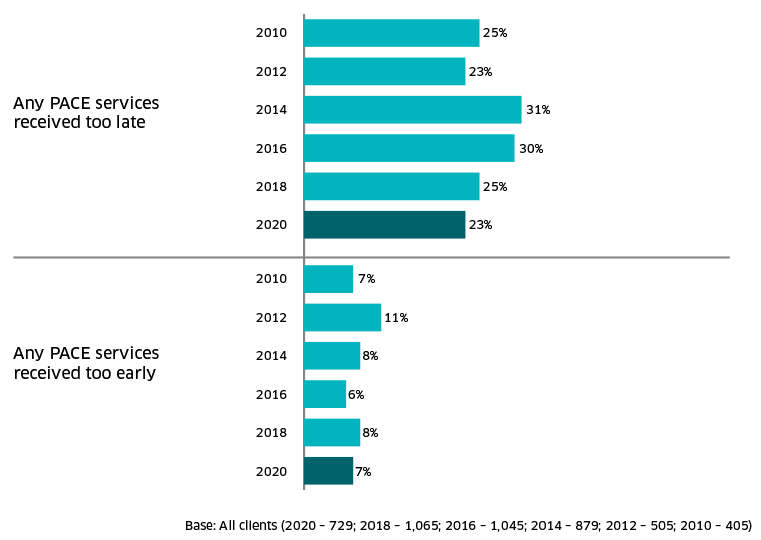
Client views on the timing of PACE services
4.28 A further indicator of the usefulness and relevance of PACE services is whether clients felt that they could access them at an appropriate time in their redundancy. Respondents were asked whether they felt support was offered too early, too late, at around the right time, or at the perfect time for them. Table 4.1 details clients’ views on the timing of delivery for each service received.
4.29 As in 2018, most clients reported that services were delivered at the time they needed them. As shown in Table 4.1, three-quarters or more of clients felt that the timing of services offered was ‘perfect’ or ‘about right’ for each of the services.
| View on timing of service offer | |||||||
|---|---|---|---|---|---|---|---|
| Base | Timing perfect | Timing about right | Too early | Too late | Don’t know/prefer not to say | ||
| PACE Presentation and Guide | (591) | % | 27 | 49 | 4 | 19 | 1 |
| Career Guidance Interview | (337) | % | 28 | 52 | 3 | 15 | 2 |
| Career management and employability workshops | (222) | % | 31 | 51 | 4 | 13 | 1 |
| Information about training and funding sources | (441) | % | 29 | 51 | 3 | 16 | 1 |
| Benefits Information |
(400) | % | 31 | 51 | 3 | 13 | 2 |
| Money Advice Service | (179) | % | 39 | 53 | 1 | 7 | 0 |
| Help with CVs, applications and letters | (407) | % | 35 | 48 | 2 | 14 | 1 |
| Help with interviews and job search strategies | (315) | % | 35 | 46 | 3 | 15 | 1 |
| Advice on Business Start up | (156) | % | 31 | 48 | 6 | 12 | 3 |
| Help with reading writing and numbers | (51) | % | 31 | 53 | 2 | 12 | 2 |
| Help to cope with redundancy-related stress | (131) | % | 34 | 51 | 2 | 12 | 1 |
| Help with understanding tax responsibilities | (104) | % | 39 | 48 | 2 | 8 | 3 |
| Handbook titled ‘Positive Steps to your Future’ | (316) | % | 29 | 51 | 3 | 16 | 1 |
| Help with Pensions from PensionWise | (165) | % | 29 | 48 | 1 | 10 | 4 |
Base: All who have accessed each PACE service (as shown for each row).
Note: Data is shown as row %ages.
4.30 Clients felt that the support received through the Money Advice Service was particularly well timed (92% felt it was ‘perfect’ or ‘about right’), help with understanding tax responsibilities (87%), help to cope with redundancy-related stress (85%), help with reading writing and numbers (84%), and help with CVs, applications and letters (83%). These are encouraging results given that these services are among the most time-critical when facing redundancy, as they involved financial implications, emotions and returning to work. The services considered to be well timed in 2018 were the same as in 2020, highlighting a consistency in service.
4.31 Where respondents were not completely happy with timing, this was because services were delivered too late rather than too early. Clients were least likely to feel that the delivery of the introductory PACE presentation and guide was timely (76% felt the timing was perfect or about right). However, the perceived timeliness of this service is similar to that for 2018 (75%) and has improved since 2016 (where 69% felt it was either perfect or about right).
4.32 Overall, Figure 4.5 shows a comparison of where clients reported the timing as being anything other than right, across all six waves of the PACE Client Experience Surveys. The proportion of clients reporting at least one PACE service was delivered too late has decreased significantly from 31% in 2014 and 30% in 2016, to 25% in 2018 and 23% in 2020. On the other hand, a smaller number of clients (seven %) reported at least one PACE service was received too early; which is in line with all previous years except 2012 when the figure was a little higher at 11%.
Use of online PACE support and the PACE contact centre helpline
4.33 Use and awareness of online PACE support continues to be relatively low. As illustrated in Figure 4.6, just 13% of all clients surveyed had used any online support provided by PACE. Around a quarter (27%) were aware of online support services offered but had not used them, and the remaining 60% were not aware of any online support offered or don’t know (58% ‘not aware’/two % don’t know).
4.34 Where clients had used online services, their views were very positive. In line with findings from 2018 and 2016, nearly all (93%) of those who had used online services said that they were satisfied with the service they received.
4.35 Clients were also asked about their awareness of the PACE contact centre helpline. Levels of awareness of the helpline were very similar to online services, with two in five (36%) of respondents aware of this service, and only very few clients (four %) who had used it; similar to the 2018 and 2016 findings.
4.36 Levels of satisfaction with the helpline were encouragingly high among those few that had made use of this service (90% ‘very’ or ‘quite satisfied’).
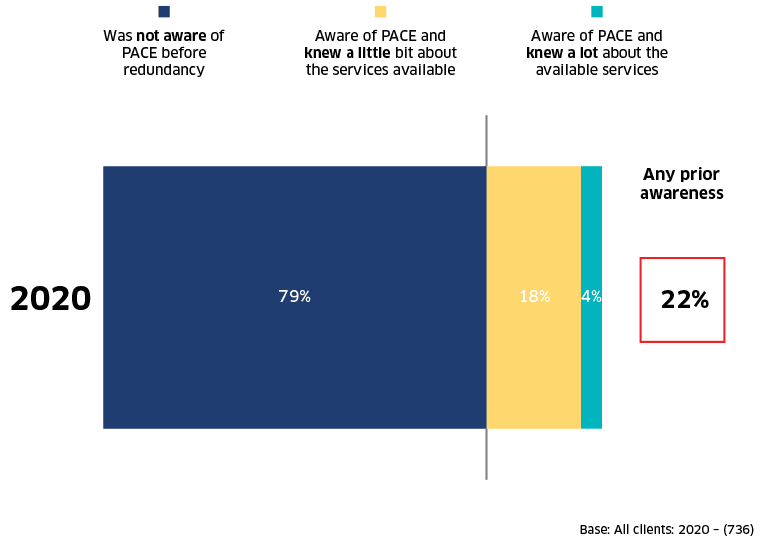
4.37 For both the online services and the contact centre helpline, awareness and usage levels were relatively low, yet among those that use them satisfaction levels are high. It is possible, therefore, that greater promotion of these services to raise awareness and use of these services may further enhance clients’ overall experiences of PACE.
Awareness of PACE services prior to receiving support and use of other redundancy support services
4.38 Just over a fifth (22%) of PACE clients were aware of PACE before receiving redundancy support, four % of clients reported knowing about PACE and knowing a lot about their services. One in five (18%) of clients had heard of PACE but did not know in detail about the services available. The level of prior awareness of PACE has decreased by six % since 2018 when over a quarter (27%) were aware of PACE.
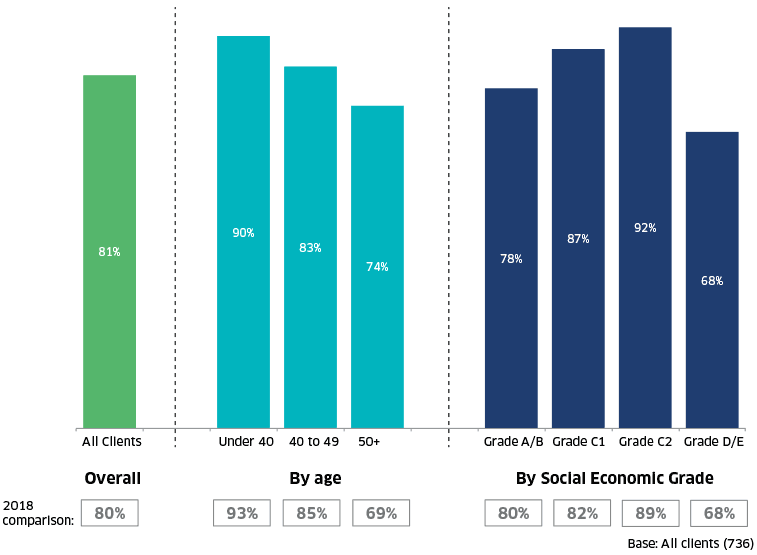
4.39 Older clients were significantly more likely to be aware of PACE but not know much about the services available (20% of those aged over 50 compared with 12% of those aged between 40 to 49).
4.40 PACE appears to be the main form of support that clients received after being made redundant (80% of PACE clients did not work for companies that used any other form of support). Only a sixth (14%) of PACE clients worked for employers who used other redundancy support services; this is a reduction from the proportion in 2018, where 20% had used other services from their employer beside PACE.
Contact
Email: margaret.sutor@gov.scot
There is a problem
Thanks for your feedback